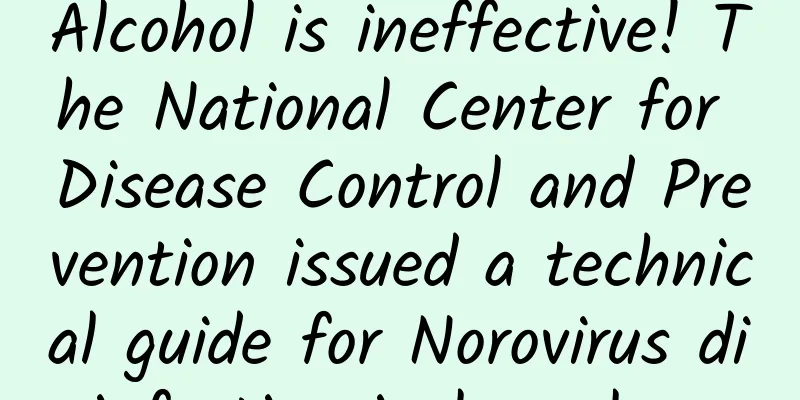Alcohol is ineffective! The National Center for Disease Control and Prevention issued a technical guide for Norovirus disinfection in key places

|
On November 30, the National Center for Disease Control and Prevention issued the "Technical Guidelines for the Prevention, Control and Disinfection of Norovirus Infection in Key Places such as Schools". During the epidemic of Norovirus infection, key places such as schools, childcare institutions and nursing homes should take preventive measures and use appropriate disinfectants regularly for preventive disinfection. Norovirus is most prevalent in the autumn and winter. It is highly contagious, has a short immune protection period, and the entire population is generally susceptible. Norovirus infectious diarrhea outbreaks are prone to occur in places where people gather, such as schools, childcare institutions, and nursing homes. The guidelines are intended to guide key places such as schools, childcare institutions and nursing homes to carry out preventive disinfection during the epidemic of norovirus infection. The guidelines clearly state that when patients infected with norovirus are found in key places such as schools, they should be isolated in time and disinfection measures should be taken as soon as possible. When a patient vomits in crowded places such as classrooms or dormitories, other people should be immediately guided to move to a relatively clean direction and the vomit should be disinfected; at the same time, the environment and supplies contaminated by vomit should also be disinfected. The guidelines suggest that during the epidemic of norovirus infection, key places should take preventive measures and regularly use chlorine-containing disinfectants or other suitable disinfectants for preventive disinfection. If any employee or student has symptoms such as vomiting, diarrhea, abdominal pain, etc., they must not go to work or attend classes while sick, and must go to the hospital for medical treatment if necessary. In addition, the guidelines introduce disinfection methods related to norovirus. This virus is highly resistant to commonly used disinfectants, and alcohol is ineffective against it. High-level disinfectants or effective physical disinfection methods should be used. For large amounts of pollutants such as vomitus and excrement of patients, disinfectant powder or bleaching powder containing absorbent ingredients should be used to completely cover them, or disinfectant dry towels that can achieve high-level disinfection should be used to completely cover them. After disinfection for the action time, carefully clean them . For small amounts of pollutants, disposable absorbent materials can be dipped in chlorine-containing disinfectants with an effective chlorine content of 5,000 to 10,000 mg/L, completely covered, and allowed to act for more than 30 minutes, and carefully cleaned. Avoid contact with pollutants during the cleaning process. Planning and production Source: Beijing Daily Client Editor: Wang Mengru Proofread by Xu Lailinlin |
<<: Academician Chen Jiansheng: Decoding the Universe: The Golden Age of Space Surveys is Coming
Recommend
Three common misunderstandings about hair care, must read before you have hair loss!
Mixed Knowledge Specially designed to cure confus...
How to write a promotion plan for new media operations?
Introduction: How does a new media director write...
The new Audi A4L once again points the way for the development of automobiles: the pursuers behind will only go further and further away
From any perspective, Audi can be regarded as the...
Experts use UC information flow, how to deliver UC headlines?
Mobile information flow ads have been very popula...
Delivery capability is the best in the world! Tianzhou launches new products, 3 launches in 2 years
In 2023, China officially entered the manned spac...
I was eating melons and my research project was wrong! I quickly wrote an article to refute it...
Some time ago, when I was surfing the Internet, I...
Zhao Dongxuan: Business model + implementation case analysis
Course Catalog├──1 -Course Study Guide, must read ...
The "smallest sun of the year" appeared in the sky today, at 15:11!
At 15:11 on the 4th, the Earth reaches its orbita...
Product Analysis | Zhihu App product operation analysis report!
From a niche elite community to a knowledge mento...
Top 10 laptop battery life: Blackie tops the list
Even though mobile phones and tablets are becomin...
How to write the copy for Qingming Festival?
When we think of Qingming What other associations...
April 2022 "Science" Rumors List: Drinking Coke will cause a positive antigen test? Dogs also shed tears when they are wronged?
The monthly "science" rumor list is gui...
You don’t have any of these, and you say you can write code?
[[129460]] Have you heard of SEMA? It's a pre...
The dangers and opportunities of online marketing during the epidemic
As the holiday time continues to extend due to th...
Have you ever had a dream within a dream? What exactly is a dream within a dream?
Image source: Tuchong Creative Have you ever had ...









